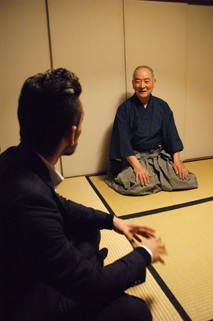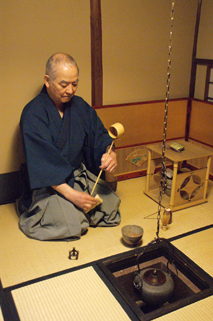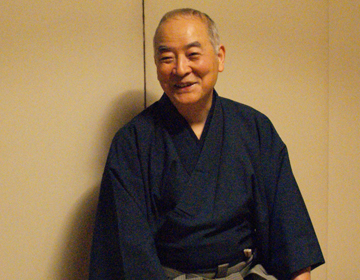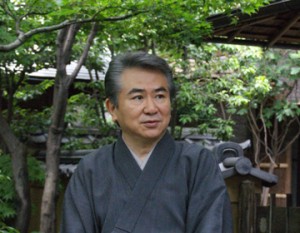Two separate paths of “sado” after Sen no Rikyu

Tea ceremony is associated with Sen no Rikyu. ”Sado”, the ritualized tea ceremony which was refined by Sen no Rikyu, split into two paths during the Edo period. One is the ”wabi” tea, spread by Senke’s Soutan the 3rd. He further expanded the world of tea started by his father Rikyu.
The other was the ”kirei sabi” carried on by one of his disciples, Shigenari Furuta. ”Kirei Sabi” as the word in Japanese implies, means adding beauty and richness to the world of ”wabi sabi,” tea ceremony aspiring for the beauty of harmony. The feudal lord Kobori Enshu developed it further, carried on to the present. We visited Kobori Enshu-style 16th Iemoto, Kobori Soen.
We were invited to the ”yoritsuki” upon our arrival. This is where you prepare for the tea ceremony, while waiting for your host. At an actual tea ceremony, you would change your ”tabi” and prepare your belongings.
We were told to moisten our mouths with hot water and ring the bell as many times as the number of people. This is so that those preparing in the back know how many guests are in the group. If the number of rings is less than the planned number of guests, they know that ”someone was unable to come”.
Heading to the Tea

We were then escorted through the garden towards the tea room. Once the last person entered the room, the door to the room was closed firmly with an audible sound. A small cough is a signal to the host to let him know we are all prepared. With this, Kobori Soen appeared.
He warmed the tea bowl and added the matcha. He whisks the matcha, and pours hot water from the kettle. After whisking the tea powder for a short while, more hot water is added. Finally he whisks one last time. The movements flow smoothly together. The word ”graceful” perfectly describes the movements, as we observe in admiration.
When the tea bowl is set in front of you, you move it close to your knees. You then hold your ”fukusa” in your left hand, place the tea bowl on the ”fukusa” and then you bring the bowl to eye level to admire the inside of the tea bowl. This is similar to observing the color of wine before tasting it. You then slowly take one sip.
”How is the temperature?”
”Very well.”
Finishing the tea in 3 and a half sips, the tea bowl is placed on the ”tatami” mat, and the rim is wiped with paper. Lastly, the ”fukusa” is placed next to the bowl.
Don’t be so Nervous

After the tea, we relax and started a conversation. ”I was worried I would do something that wasn’t allowed.” were Nakata’s first words.
Upon hearing this, Kobori smiled and said, ”There’s no such thing. Just behave the way you normally would.”
”For a tea ceremony, bring ”kaishi”, a toothpick for the Japanese sweet, ”fukusa” and a handkerchief. These 4 things are all you need. That’s it. Many men attend in their suits. So I want people to relax and take part.”
”Sado” may seem intimidating if you are not familiar with the practice. But along with the refined flavor of the tea, one might find the sophisticated ambience to be quite addictive.
Tea ceremonies are also an opportunity to take in the special utensils. Now fully relaxed, Nakata glanced at the hearth. ”Today, I prepared the hearth that was presented to me by KumanohayatamaTaisha.” Thoughtful gestures like this make tea ceremonies that much more delightful.




